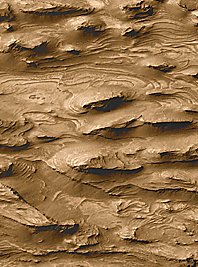Click on image for full size
NASA/JPL/Malin Space Science Systems
Related links:
Exciting News from the Red Planet!
News story originally written on December 19, 2000
The Mars Global Surveyor
(MGS) was launched on November 7, 1996. It has been in orbit around
Mars for over 1500 days. It may have made its greatest observation this
month!High-resolution pictures taken by the MOC (Mars Orbiter Camera) aboard the MGS show layers of sedimentary rocks that could be evidence of past lakes and seas on Mars. As on Earth, sedimentary rocks hold the history of the planet.
"We see distinct, thick layers of rock within craters and other depressions for which a number of lines of evidence indicate that they may have formed in lakes or shallow seas. We have never before had this type of irrefutable evidence that sedimentary rocks are widespread on Mars," said Dr. Michael Malin, principal investigator for the Mars Orbiter Camera on NASA's Mars Global Surveyor spacecraft. "These images tell us that early Mars was very dynamic and may have been a lot more like Earth than many of us had been thinking." Malin added, "I have not previously been a vocal advocate of the theory that Mars was wet and warm in its early history. But my earlier view of Mars was really shaken when I saw our first high- resolution pictures of Candor Chasma. The nearly identically thick layers would be almost impossible to create without water."
But, these observations are only one piece in a very complex puzzle. Some scientists think that the layers within these sedimentary rock formations are so prominent because Mars was actually a lot colder and drier 3.5 billion years ago, allowing for more dust to be airborne and thicker layers to be formed.
It may seem confusing that some scientists take these observations as confirmation of a wetter, warmer Mars, while others think exactly the opposite thinking of a colder, drier Mars. This is the wonder of the field of science. Only with further investigation, discussion, and missions to the Martian surface will we know for sure what these awesome surface features tell us about the history of the Red Planet.
"Mars seems to continually amaze us with unexpected discoveries,"
said Dr. Edward Weiler, Associate Administrator for Space Science
at NASA Headquarters. "This finding just might be the key to
solving some of the biggest mysteries on Mars, and it also tells us
that our new Mars exploration program needs the flexibility to
follow up in a carefully thought-out manner."















